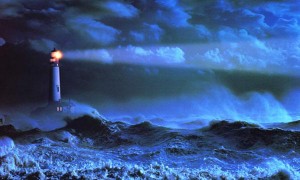How Does a Lighthouse Work
Including some of the most impressive man-made structures in the world, lighthouses have played a pivotal life-saving role throughout history.
Lighthouse work by rhythmically flashing a rotating light in order to transmit a visual signal to surrounding vessels. This is done so that conditions that provide poor visibility can be mitigated by approaching sailors, allowing them to safely manoeuvre while close to the shore. The individual pattern of flashes or eclipses -referred to as the light’s character – determine the transmitted message and these can range from collision warnings to weather reports, directional guidance to the position of other vessels and structures. The breadth and types of characters a lighthouse can use is determined by the International Association of Lighthouse Authorities in Paris.
Lighthouse construction emanated from the practice of lighting beacon fires upon hilltops, something first referenced in Homer’s Iliad and Odysseyin the 8th Century BC. However, it was not until 280 BCE, when the architect Sostratus built the Great Lighthouse of Alexandria on the island of Pharos, Egypt, that man-made lighthouse structures began to be built across the entire globe. Since then the style and complexity of the structure, light source and fuel has changed greatly, with intricate designs formed dedicated to advancing the light-saving technology. We takes a closer look at a classical lighthouse and its constituent components.
![Lighthouse Lighthouse]() How Lighthouses are made
How Lighthouses are made
1. Lighthouse Tower
Lighthouse towers are usually either built onshore or directly on the seabed. This is best shown in the caisson method, where an open-ended cylinder is sunk and filled with concrete to form a solid base. However the latter is less common due to the erosion suffered by sea waves. Towers have a distinctive shape and colour – often a top-tapered, white tower – to help sailors identify them. Within the tower it is also common to find the lighthouse’s service room, the place where the fuel/generator is kept.
2. Light source
Early lighthouses used open fires and large candles to create light. During the classic period of lighthouse usage, lanterns burning animal oils were common. Gas lamps were also used around the turn of the 20th Century. Modern lighthouses use electric lamps and bulbs.
3. Lantern room
 Arguably the most important aspect of the lighthouse, the lantern room is the glassed-in structure that sits at the pinnacle of the tower. Commonly, lantern rooms are fitted with storm panes and metal astragal bars in order to withstand the harsh weather conditions it is exposed to, as well as a ventilator in the roof to remove any smoke and heat caused by the lamps within – obviously, smoke is not an issue with electric lamps. Lantern rooms are often surrounded by a gallery, which is used for cleaning the windows.
Arguably the most important aspect of the lighthouse, the lantern room is the glassed-in structure that sits at the pinnacle of the tower. Commonly, lantern rooms are fitted with storm panes and metal astragal bars in order to withstand the harsh weather conditions it is exposed to, as well as a ventilator in the roof to remove any smoke and heat caused by the lamps within – obviously, smoke is not an issue with electric lamps. Lantern rooms are often surrounded by a gallery, which is used for cleaning the windows.
4. Fresnel lens
The Fresnel lens allows for a light source to be amplified way beyond its standard imitable ability in a certain direction and done so with fewer materials than a conventional spherical lens. It achieves this by redirecting light waves through a series of prisms arranged in a circular array, with steeper prisms at the edges and flatter ones near the centre.


